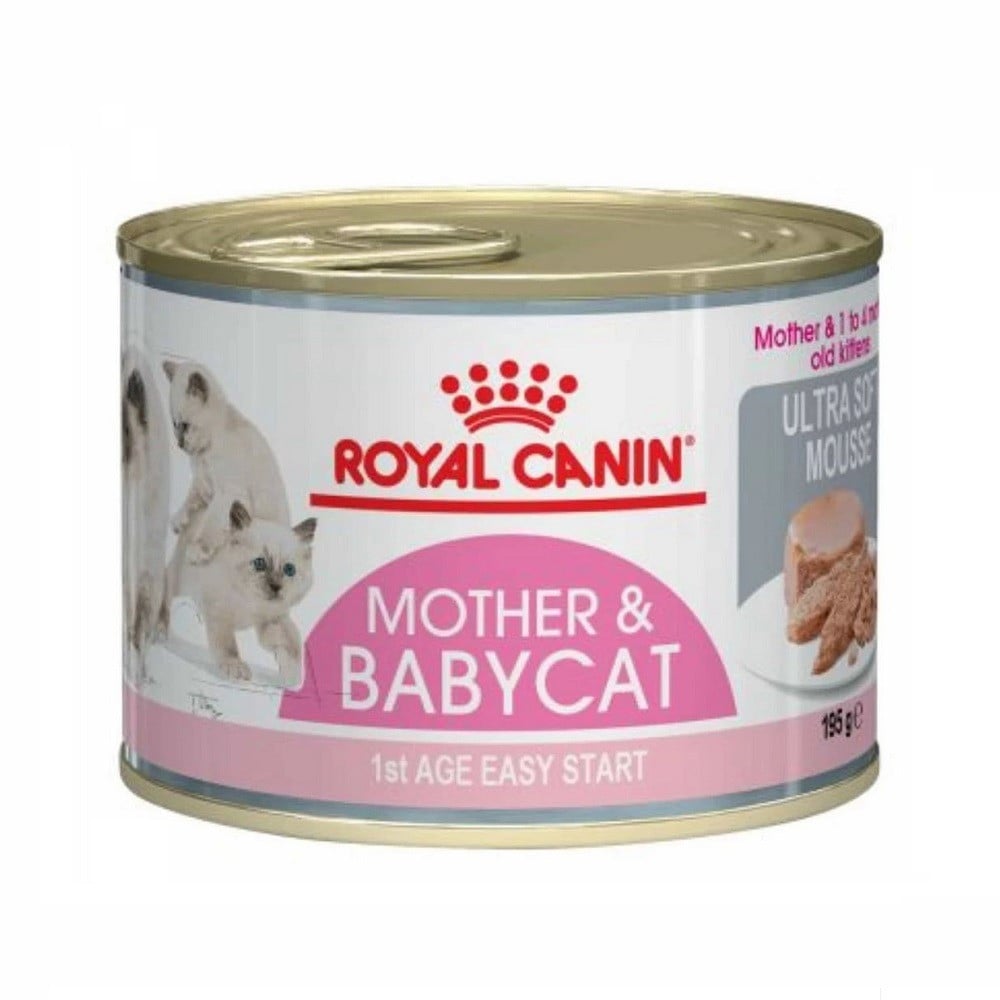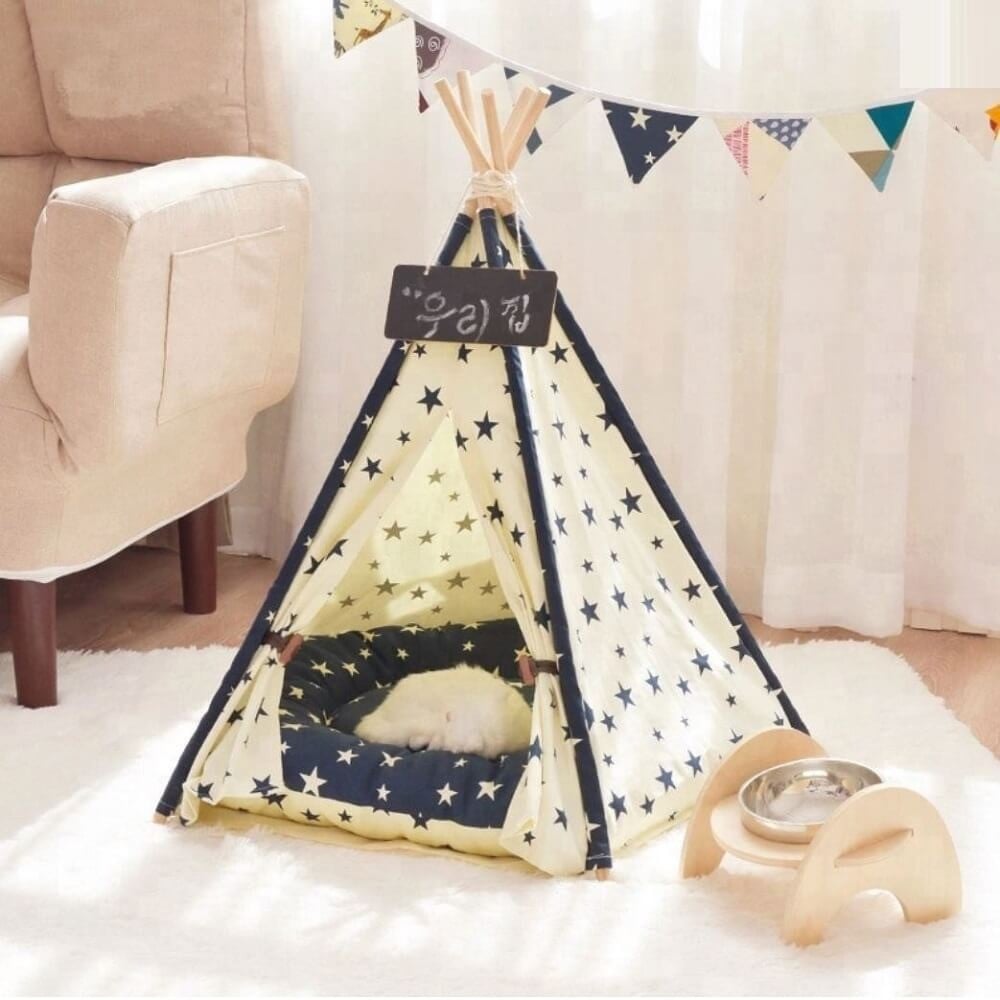
New mother cats are often confused and frightened and need special care and attention. So if your cat has recently given birth, she will need your attention and care. So we offer you a complete guide on caring for your cat after birth the best you can. At Petaholic, we also provide you with all pet supplies to provide the best care for your cat and its kittens.
What should I do to care for and care for my cat after giving birth?
After your cat gives birth, it's really important that you keep a close eye on her and her kittens to make sure they're all happy and comfortable. Your cat will provide the kittens with everything they need naturally. So try to keep your distance if you can until you can settle into motherhood. Also, after your cat is born, you will need:
- Keep the room warm for the mother cat and kittens.
- Make sure their bedding is clean and dry.
- Keep the room quiet and do not allow family members to continue harassing her.
- Monitoring the kittens to make sure they are feeding, but keeping a comfortable distance for your cat, should begin almost immediately after birth. If they don't start after half an hour, guide them gently.
- Keep other pets in the house away from your cat and her kittens.
Steps to care for the mother cat and the babies after birth.
1.Feeding
Caring for kittens depends on several factors, including their age, the presence or absence of the mother, and their health condition. If the young are found separated from the mother, the mother must be provided with care, such as food, warmth, and assistance with meeting their needs. It is best to take time to consider the situation before you start caring for them.
If you find kittens and think their mother has abandoned them or gone missing, observe them from afar for a while to see if the mother returns. If the young are in immediate danger, for example, if they are exposed to extreme cold or threaten to be trampled, you must intervene immediately without waiting for the mother to return.
2. Feed the mother constantly
Offering food to the mother cat is a good move if she is nearby. If the mother is interested in taking care of the young, it is preferable to let her do that. However, you can continue to help by putting food and providing shelter for the mother. Just make sure you put the food and shelter in different places, otherwise the mother may not accept them.
3. Feeding the young
Feed the young yourself if the mother is not around or is unable to care for them. Prepare their food and offer it regularly. The type of food you will offer depends on the age of the kittens, and be sure to consult your vet about the appropriate type.
When the kittens are between two weeks and one month old, feed them every two hours using a bottle filled with commercial breast milk substitute milk. Avoid giving them cow's milk, as it is difficult for their body to digest.
When they are 3-4 weeks old, put the milk in a deep dish next to some kitten food mixed with water. Feed this food to them 4-6 times daily.
When they reach 6-12 weeks old, increase milk intake and start offering dry kitten food, 4 times daily.
4. Weigh the cat constantly
Weigh the kittens weekly to ensure they are receiving adequate nutrition and gaining appropriate weight. Record their weights to track progress. Cats should gain between two and a quarter to three and a half ounces per week. If weight is not gaining at an appropriate rate, please speak with your veterinarian for additional guidance.
5. Leave the young ones to the mother for the first week
Leave the babies alone during the first week if the mother is present. In the event that kittens are repeatedly carried and rejected by the mother, it is preferable to leave them alone if the mother cat is present nearby. However, young are best trained to be held by humans between 2 and 7 weeks.
6. Designate a place for children to sleep.
M provided a special place for the little ones to sleep. If they don't have a place to sleep, make sure you provide them with a warm, dry place, away from potential dangers. Check that the location you have chosen for them is warm, dry and away from drafts. You can use a cat carrying box and surround it with clean towels or blankets.
7. Encourage them to use the litter box from the age of 4 weeks.
Encourage the kittens to use the litter box when they are 4 weeks old. At this time, the kittens will be ready to start using the litter box. To encourage this, put each cat in the box after they finish eating. Once she's finished using the box, return her to her place next to her littermates, and repeat the process with another cat. Let each cat use the box for two minutes after each meal.
8. Help children relieve themselves when necessary
Help the little ones relieve themselves when necessary, especially if the mother is not nearby. In the first weeks, you can help the little ones relieve themselves. Use a damp cloth or old piece of clothing to gently massage their sensitive areas, one cat at a time, until they relieve themselves. Wash the cloth immediately and dry the kittens before putting them back in their place.
9. Let the mother cat help the children
Let the mother cat help the kittens if she is nearby. If the mother cat is close to the kittens and shows a desire to help them relieve themselves, let her do her part. In the first weeks of the young's life, the mother may lick their sensitive areas to stimulate them to urinate and defecate. In this case, it is preferable not to interfere and let the mother do her job.
While many cats have perfectly healthy births, there are some problems that can occur that you should watch out for. These signs are:
Warning signs
- Vaginal bleeding or unusual vaginal discharge.
- Uterine prolapse, where stress can sometimes push the uterus out.
- Mastitis, which is an inflammation of the mammary gland that becomes hot, painful, and engorged.
- Poor appetite, with excessive drinking or vomiting.
- Trembling or abnormal movement.
If you notice any of these problems, contact your vet immediately.
Among the wonderful products that we provide at Petaholic for mothers and their children are:

What are the behaviors of cats after giving birth and how do you deal with them?
Most cats tend to groom their kittens very naturally. You may notice your cat doing the following:
- She licks, nuzzles and purrs her newborn cubs.
- Move and move kittens out of their habitat if they feel unsafe for any reason, or if their current location is not warm enough for them. When your cat does this, don't try to stop her, instead try to provide a quiet, comfortable, and warm place for her to move to.
- Acting differently towards you: Cats are overly protective of their kittens, so you may prefer to keep your distance at first.
When do cats recover after giving birth?
The cat's postpartum recovery period depends on several factors, including the number of kittens born and their health, the condition of the mother, and the care provided to her. Generally, the recovery process can occur in the first few weeks after giving birth.
Here are some points that may affect the cat's recovery period after giving birth:
1. The cat’s general health: If the cat is in good health, the recovery period may be shorter. A healthy cat will be able to recover better.
2. Number of kittens: If there is a large number of newborn kittens, the mother cat may need more time to meet her needs and take care of the kittens.
3. Postpartum care: Good postpartum care plays an important role in a cat's recovery. The cat owner must provide a calm and warm environment and ensure that the mother cat eats rich, nutritious food.
4. Control breastfeeding : The cat must continue to breastfeed and provide milk for the kittens. If there are problems with lactation or the health of the kittens, the cat may need further veterinary care.
5. Veterinary visits: It is preferable to visit a veterinarian to evaluate the health of the mother cat and the kittens, and to receive advice about subsequent care and nutrition.
Although the cat may recover quickly in the first weeks, it is important to monitor its health condition and ensure that it receives adequate care during this important period.
What should I do after my cat gives birth?
After your kitten is born, here are some important guidelines that can help you take good care of the kittens:
Providing a warm place: Make sure you have a quiet, warm place for the kittens, where they can relax and take shelter. You can use a special cat box with a soft mattress.
Health care: Make sure that the kittens absorb the milk provided by the mother. If there are any problems with feeding, you should contact your veterinarian.
Visit the vet: Visit the vet as soon as possible to examine the kittens and make sure they are healthy. It may be necessary to give them vaccinations and immunizations.
Good nutrition: The mother cat needs good, nutrient-rich food to support milk production. Your vet may suggest a specific type of food for her.
Weight Monitoring: Keep track of the kittens' weight to ensure they are developing properly. If you notice any abnormal changes, contact your vet.
Providing attention and affection: Kittens may need a lot of attention and affection in the first weeks of their lives. Provide play and positive interaction.
Litterbox training: If the kittens start moving and exploring, train them to use the litterbox.
Always remember to consult your vet if you are unsure or if health issues arise. Good care in the first weeks helps build a strong, healthy foundation for the kittens.
It is normal for your cat's behavior to change slightly after its birth, but it stabilizes after a few weeks. Sometimes your cat's behavior is a cause for concern, and that's when you want to call your vet. Some of the strange things in cat behavior that you should look for in order to care for a cat after birth and her kittens as well include the following:
- Severe distress or pain can cause a mother to kill her young. The risk of this happening can be reduced if the mother is more accepting of the environment around her and feels safe, reassured, calm, and enjoys good health. So you have to be very calm and only disturb the mother when necessary.
- If a mother seems to be ignoring or rejecting one of her kittens, applying some birth fluids to the kittens she is rejecting may help her accept her.
Among the special products that your cat will need after giving birth are:
What things do cats need after giving birth?
Privacy
Cats love privacy, and giving it to them will provide your cat and her kittens with the right environment to recover and rest well for the next several days. While this may seem like an unexpected part of postpartum kitten care, it is an important part so that the mother cat can decompress and take care of her newborn kittens.
Feed kittens after birth with high-quality food
You may be wondering what a cat eats after giving birth. You should give your cat a good quality veterinarian-recommended food so that she gets the vitamins and nutrients she needs to gain strength and produce enough milk for her kittens. Baby kittens are usually fed every two hours after birth. You'll know when they have to feed because they'll start crying and moving around. Therefore, you should help the cats take turns while feeding, allowing the youngest to breastfeed first. Thus, the cat needs good nutrition after giving birth to be able to constantly provide milk for its young. Here are the nutritional priorities that a mother cat needs:
- Caloric energy for kitten growth and milk production for the mother.
- Protein for healthy growth of cats.
- Fats to provide the mother's increasing need for calories.
- Calcium and phosphorus for kittens' bone growth and mother's milk production.
- High digestibility to provide more calories in less food.
How do I deal with a newborn cat without a mother?
Caring for a newborn cat without a mother requires special attention and extreme care, as the mother is the one who usually meets the needs of the kittens in the first period of their lives. If you find yourself responsible for caring for a newborn kitten without a mother, here are some steps you can take:
-Provide warmth : Use a warm box and a soft blanket for the kitten. You can place a heat source such as a heating pad or heat lamp to help maintain its temperature.
-Proper feeding: If the kitten cannot breastfeed from its mother, you will need to feed it manually. Use a small bottle or syringe to feed him formula cat milk, which can be found at pet stores. Ask your vet about the right amounts and timing.
Stimulate excretion: Use a piece of damp cloth to stimulate the kitten to urinate and defecate, as the mother often cleans them in this way.
-Medical examination: Visit the veterinarian as soon as possible to ensure the kitten's health and to obtain additional advice based on the individual case.
-Care and interaction: Provide affection and care to the kitten. You may need to provide play and attention to compensate for the lack of attention that may result from the loss of the mother.
Remember that daily care and attention to any changes in the kitten's behavior will be necessary. If you are unsure or if there is any health problem, you should contact your vet.
Cleanliness is one of the most important elements of caring for a cat after giving birth
When caring for a mother and her kittens, it is always important to maintain good hygiene in their area. Always keep the kittens dry, warm and away from all soiled materials inside the whelping box. Use pads that you can change regularly if they get dirty or wet.
Keeping your mother cat and kittens dry, warm and clean is very beneficial to prevent them from contracting and developing infections and diseases. You can also give your cat a bath after giving birth, but you must wait at least two or three days. This will allow your cat to vaccinate her cervix after giving birth. Meanwhile, you can use a wet towel to help clean it.
Can cats be sterilized after giving birth and what is the impact on their health?
Spaying your cat after birth depends on how quickly she weans her kittens. This may be from 4 weeks or even 8 weeks or more in some cases after the young are weaned. Since your cat is nursing her kittens almost around the clock, it is not a good idea to have her spayed before she stops breastfeeding. This can make surgery more difficult and prone to complications due to enlarged mammary glands, and many vets are unlikely to want to perform the procedure until their kittens are completely weaned anyway.
Among the distinctive products that we offer for your cat at Petaholic that help you provide safety and calm for your cat and its kittens:
How do I deal with a two-week-old cat?
Caring for a kitten at two weeks old requires great attention and careful care. Here are some tips on how to handle a cat at this age:
-Providing warmth: A kitten at this age may not be able to maintain its body temperature well. Use a heating pad or heat lamp to help keep his temperature between 85-90°F (29-32°C).
-Milk feeding: At this age, the kitten depends on artificial cat milk. You can use a feeding bottle or plastic syringe to hand-feed him. Ask your vet about the quality of milk and how to introduce it properly.
Stimulate excretion: The kitten may need help with urination and defecation. Use a damp cloth to stimulate these processes, and do so after every meal.
-Visit the vet: It is important to visit the vet to examine the kitten and make sure it is in good health. Your vet can provide advice on proper care and feeding.
-Play gently: You can offer some gentle play to the kitten. Play helps stimulate their activity and develop their skills.
-Attention to cleanliness: Gently clean the kitten using a soft cloth if necessary.
Always remember that at this age, care must be meticulous to ensure the kitten's health and good development. If you are unsure or if there are any health problems, you should contact your vet immediately.
In the end, newly born kittens need special care and great attention because it is a stressful and difficult stage, and the cat needs your full attention. At Petaholic, we have provided you with all the products that help you provide the best possible care for your cat and its kittens at the lowest prices.
We also have:


